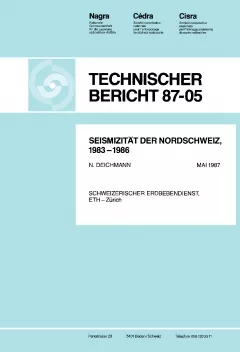
Technischer Bericht NTB 87-05
Seismizität der Nordschweiz, 1983 – 1986
Since 1983, as part of a general neotectonic research programme undertaken by NAGRA, the Swiss Seismological Service has been monitoring in detail the seismicity of northern Switzerland. The aim of the project consists of investigating the relation between the spatial distribution of micro earthquakes and the possibly still active fault systems visible at the surface from geological observations.
Over the four-year period from 1983 to 1986, the nationwide seismic network, together with a local temporary telemetry array installed at the end of 1983, recorded roughly 100 earthquakes in the magnitude range between 0.9 and 4.2, located in northern Switzerland and the immediately adjacent region of southern Germany. Five of the earthquakes were sufficiently strong to have been clearly felt over a larger area by the population. The seismic activity was concentrated mainly in the west, along a strip extending from the southern Black Forest to the Folded Jura Mountains, and in the east, in several locations between the Bodensee (Kanton Thurgau) and the Albis (Kanton Zurich). The activity was lowest in the central part of the region under study, with a total of 7 events, all having magnitudes less than 2. Contrary to most observations of seismicity in intracontinental settings throughout the rest of the world, focal depths of earthquakes are distributed throughout the earth's crust, almost reaching the depth of the crust-mantle boundary. Focal mechanisms derived from fault-plane solutions are mostly of the intermediate type between pure strike-slip and normal faulting, and are generally consistent with directions of the horizontal components of maximum and minimum compressive stresses striking roughly NW-SE and NE-SW respectively. In several cases, it was possible to apply a cross-correlation technique to the signals, to obtain highly accurate locations of hypocenters relative to a master event; in the case of six closely grouped earthquakes, located at a depth of about 23 km, the relative distribution of hypocenters coincided exactly with the orientation of one of the focal planes derived from the fault-plane solution of the master event.
On the whole, seismic activity in northern Switzerland is low. Consequently, even though some local trends have started to appear, the data recorded so far is still insufficient to establish a general pattern that can be related to the surface geology. Thus, the present study is to be considered as an interim report of an ongoing research project.
